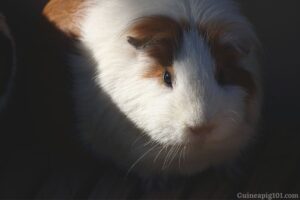Are guinea pigs allergic to radish?
It is fortunate that guinea pigs are not allergic to radish; nonetheless, due to the high concentration of oxalates found in radish, it should only be served as a special treat to them.
The green section of radish is particularly popular among guinea pigs, despite the fact that many of them loathe its flavor in general.
Providing your guinea pigs with an excessive amount of radish can be harmful since it contains an excessive amount of calcium, which can contribute to bladder stone formation, which is a common health problem in guinea pigs.
Do guinea pigs like radish?
Guinea pigs can eat radish, although for the most part, they do not enjoy these veggies very well.
The radish tops and radish leaves can be served because the guinea pigs normally enjoy them and will gladly nibble away on them.
Since they will neglect radish when it is presented to them, keep an eye on their preferences and feed them just in little amounts. That will ultimately assist you in determining whether or not to offer this treat again in the future.
Are guinea pigs allowed radish? (Hazards you must know)
Yes, guinea pigs are permitted to consume radish, but only seldom for the purpose of tasting it.
The reason for this is because radish is high in oxalates, which bind with calcium and cause bladder stones in those who consume it.
Oxalates accumulate in the kidneys as a waste product as a result of an excess of oxalates. It causes serious harm to the guinea pigs’ urinary system, resulting in the development of urinary stones in the animals.
The following are some of the dangers you should be aware of when giving radish to your guinea pigs.
- Urinary complications: Radish has lots of calcium as this mineral helps to form healthy bones, but should not be fed to fully grown-up pigs.
- It will cause several problems like a frequent infection in the urinary bladder, blood in urine, stones in kidneys, and bladder.
- Research has shown that most of the cases of urinary stones in guinea pigs are caused by calcium and oxalates binding.
- Bad digestion: Radish contains a specific spicy and bad aroma, which becomes painful for their stomach and it also upsets the belly of your guinea pigs.
Is radish good for our guinea pigs?
Yes, radishes are fine for guinea pigs to eat, but they should only be fed after being well rinsed in a water solution or vinegar solution.
As a result, all of the contaminants in it will be removed, and the food will be safe for the guinea pigs to consume.
Radishes provide a high concentration of nutrients. As a result, it should only be severed in moderation.
Radishes can be beneficial to our guinea pigs as well, and we should consider feeding them. The following are some of the advantages:
- Provides Vitamin C: Guinea pigs need Vitamin C to survive and stay healthy. Radish contains a moderate amount of Vitamin C in it. Lack of vitamin c can lead to scurvy in guinea pigs.
- Fiber content: Guinea pigs are generally herbivores. Radish contains the right amount of fiber in it, which is beneficial for guinea pigs. That will help in proper digestion. Lack of fiber can lead to diarrhea and starvation.
- Low in sugar: Guinea pigs are prone to diabetes. Radishes contain a small amount of sugar. Sugar is terrible for our guinea pigs. However, consuming radish does not affect the blood sugar level in guinea pigs.
- Iron: Iron also helps in maintaining the energy levels of our guinea pigs. Serving a lack of iron can lead to fatigue and illnesses.
- Low in calories: Radishes have a moderate amount of calories, which allows guinea pigs to maintain their weight. High calories can lead to obesity in cavies.
How many radishes can guinea pigs eat at a time?
You can give your guinea pigs a little slice of radish as a treat. Remember to combine it with other low-calcium vegetables to ensure that your guinea pigs have a well-balanced diet.
It is critical to provide your guinea pig with a well-balanced diet. The nutrition of your guinea pig is completely responsible for their overall health.
Also, keep in mind that guinea pigs prefer the tops and leaves of radish more than the radish itself.
How often can guinea pigs eat radish?
Radish should not be offered to your guinea pigs more than once or twice a month in its raw form. Its tops and leaves, on the other hand, can be served up to twice a month.
Radish contains oxalates and calcium, which are toxic to guinea pigs and should not be fed to them. Calcium, on the other hand, should be added to their diet in moderation.
When your guinea pig’s diet contains excessive amounts of oxalate and calcium, this might result in the creation of bladder stones and sludge. As a result, it should be served in small quantities.
Can guinea pigs eat radish leaves?
Yes, guinea pigs can consume radish leaves, but it is recommended that they do so in moderation because the leaves contain more nutrients than the radish root itself.
Radish leaves are higher in calcium, Vitamin C, iron, and phosphorus than radishes.
However, a guinea pig’s diet that contains an excessive amount of these elements is not beneficial to them. Furthermore, an excess of calcium will also lead to the formation of bladder stones.
Can guinea pigs eat radish tops?
Yes, guinea pigs can eat the tops of radish plants, but they must first be carefully washed. They should be served to your guinea pigs when they are fresh and free of chemicals.
Can guinea pigs eat radish sprouts?
Yes, guinea pigs can consume radish sprouts; however, you must be careful about how much you offer them in terms of sprouts.
Guinea pigs benefit from the consumption of radish sprouts because they aid in digestion.
It is high in various vitamins A, B, C, and E, as well as calcium and iron, both of which are vital for your pigs’ well-being.
Can guinea pigs eat radish microgreens?
Guinea pigs can consume radish micro greens, but only as a special treat once in a while.
Microgreens are plants that contain a high concentration of minerals, particularly calcium, which is detrimental to their health.
A guinea pig’s diet does not require an excessive amount of calcium.
Can guinea pigs eat daikon radish?
Yes, guinea pigs are capable of consuming daikon radish. Daikon radish, often known as white radish, is a type of radish.
In addition to calcium and phosphorus, it has a little quantity of sugar and a minor amount of acidic content.
Because of the acidic component in it, guinea pigs should not consume excessive amounts of it.
Because it has a milder flavor than other radishes kinds, they are more tolerant of it and like eating it. Before serving, it is always recommended that it be well cleaned.
Can guinea pigs eat red radish?
Yes, guinea pigs can consume red radish; however, it should only be offered in little amounts.
Excessive servings of anything to your guinea pigs might be detrimental to their health. Taking excessive doses of it can cause digestive tract difficulties in certain people.
Can guinea pigs eat canned radish?
No, guinea pigs should not consume preserved radish since it has a significant amount of salt, which is harmful to them.
Preservatives are also present in canned radish, which is detrimental to guinea pigs’ health.
Make an effort to feed them only fresh vegetables.
Can guinea pigs eat Frozen radish?
No, frozen radish should not be given to guinea pigs since they are not suitable for them. In the event that you run out of fresh vegetables, you can defrost the radish thoroughly and offer it to your guinea pigs instead.
Frozen foods, on the other hand, should be avoided because they can cause diarrhea.
Can guinea pigs eat dried radish?
No, guinea pigs are not able to consume dry radish.
Because dried radish is high in calories and sugar, it might be dangerous if consumed in large quantities.
It is not suggested that dried radish be fed to guinea pigs for a variety of reasons.
Can guinea pigs cooked radish?
No, guinea pigs cannot eat cooked radishes.
Cooked vegetables lack nutritional content, and guinea pigs lack the type of digestive system that can digest cooked foods.
Guinea pigs can eat raw and fresh vegetables but never cooked one.
Can guinea pigs eat radish pickles?
No, guinea pigs are unable to consume radish pickles.
Pickles include preservatives and salt, both of which are toxic to guinea pigs and should be avoided. Pickled Radish may also be tough for guinea pigs to digest, so be cautious when serving.
Alternatives to radish for guinea pigs
If all of this anxiety makes radish seem undesirable, we have other options to offer our guinea pigs as a substitute.
Parsnips are the most prominent of these root vegetables. Furthermore, the veggies listed below can be used to feed the guinea pigs in a modest amount of quantity.
Additional than radish, there are a few other fresh vegetables that can be fed to guinea pigs that are completely safe:
- Bell peppers
- Celery
- Chard
- Romaine lettuce
- Kale
- Carrot
- Cilantro
- Spinach
Guinea pigs can be fed any of the veggies listed above without risk of harm.
Never feed them in excess; instead, conduct a small trial. Your pigs will be safe as a result of your actions. Feed your guinea pigs by combining these vegetables with some additional healthy vegetables that are appropriate for their nutritional needs.
How to prepare radish for guinea pigs?
To prepare radishes for guinea pigs, follow these simple instructions: Let’s get this party started:
- Choose radish that is both fresh and appetizing, and soak them in water or vinegar solution for a while.
- This will assist you in removing the chemicals that are present in it.
- After taking them from freshwater, allow them to dry in the open for a period of time or use a clean cloth to remove excess moisture.
- Try to give them chopped radish instead of the whole thing because guinea pigs sometimes have difficulties chewing on a large slice of radish.
- Peeling the radish skin can be accomplished with the help of a peeler. That is optional because just a few pigs will eat radish that has been peeled off the surface, whilst others will eat radish that has not been peeled off the surface.
- Make an effort to combine radish with other nutritious veggies so that they would eat their food more happily.
- Serve them in a clean dish so that they can get the most enjoyment possible out of them.
- Last but not least, make sure the plate is removed from the guinea pigs’ enclosure. Pests and other animals, such as flies and rats, can be attracted to food that has been left out.
Conclusion: Guinea pigs and Radish
- Radish is a powerhouse of nutrients, including potassium, Vitamin C, dietary fiber, calcium, and a variety of other vitamins and minerals.
- Guinea pigs can eat radish, but it should not be given to them on a regular basis. Overfeeding can result in bladder stones as a result of an excess of calcium in the diet.
- Small slices of radish mixed with other nutritious vegetables can be fed to guinea pigs as treats.
- In guinea pigs, an excessive amount of oxalates can lead to renal and bladder stones. It makes it harder for guinea pigs to digest their food in the appropriate manner.
- It is also critical to provide your guinea pigs with only fresh and uncooked vegetables at all times.




